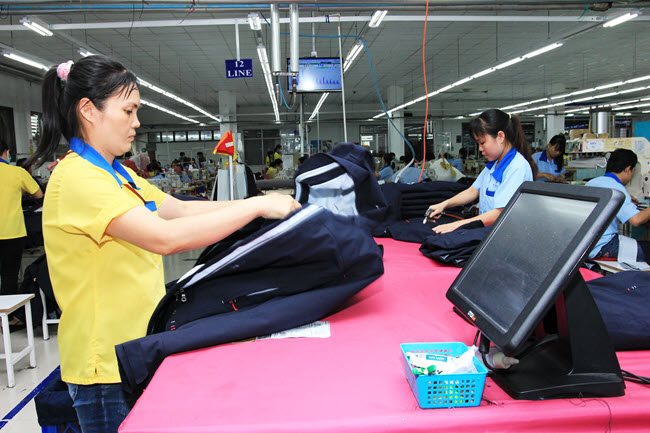Tackling labor shortage
Tackling labor shortage
The EU-Vietnam Free Trade Agreement (EVFTA) is poised to help Vietnam both create more job opportunities and improve the quality of her labor force. However, the road ahead is really tough.

Nguyen Hai Minh, vice chairman of EuroCham, says the strict rules of origin stipulated in the EVFTA will change [in one way or another] the global value chain. Many enterprises involved in the supply chain—such as textile and garments, footwear and electronics—may relocate their production facilities to Vietnam to enjoy tariff advantages given to their exports to the EU. Moreover, the trade pact—together with the Investment Protection Agreement (IPA)—will also help European companies, in particular small and medium ones, gain more confidence in their investment decisions in Vietnam.
Take for example, the textile and garment industry which is deemed to reap the biggest benefit with the signing of the EVFTA. As Vietnam’s textile and garment sector mostly does subcontracting jobs which earn the lowest added value in the value chain, the sector’s relevant in-country supporting industries—like accessories, weaving and dyeing—are weak and thus necessary products have to be imported to the country. Meanwhile, the EVFTA imposes very stringent regulations on rules of origin. To enjoy the tariff incentives, enterprises must move their supply chain facilities to Vietnam.
To seize these opportunities, the textile and garment industry must look forward to a more comprehensive development. As a result, the sustainable competitiveness in the industry should rely not only on cheap labor but also modern and more flexible production chains, or the capacity to produce fiber and fabric. In other words, the industry must strive to attain a higher rate of localization.
“A higher demand for labor supply will induce a change in the quality of labor in the new context,” says Minh. “This is a hard problem for the economy.”
Pham Hong Quan, Asia-Pacific HR head of Piaggio Group and a member of EuroCham, maintains that although Vietnam’s labor quality has been better so far, much must be done to further improve it in the coming time.
“Human resources development has been viewed with short-termism,” Quan says. “Corporate leadership skills are not so good in general. Moreover, as the large proportion of workers were born in the baby booming era, their IT accessibility and application skills remain limited.”
On the other hand, workers’ ability to teach themselves new skills is another weakness of the local labor pool, says Quan, explaining that they mainly rely on personal experience to analyze and evaluate problems to find a solution rather than making use of what is done by the corporate circles in the world.
According to EuroCham, a rather big gap can be seen between what European firms expect their work force to be able to do and what the latter is actually able to do. The lack of qualified personnel is yet another disadvantage faced by the labor market of Vietnam.
Minh adds that European firms impose stringent regulations on labor recruitment. The most common criteria include professional skills, experience, capability and foreign language command.
Soft skills—such as communicative skills, the ability to work under pressure and flexibility—are also required by Europeans employers.
The shortage of skilled labor in Vietnam applies not only to European firms but also companies nationwide. A research project conducted by the Vietnam Chamber of Commerce and Industry (VCCI) shows that 55% of the polled enterprises say they find it difficult to recruit high-skilled personnel. Another survey shows 85% of the respondents claim that recruitment of senior managerial positions is a really tough problem.
“Such quality of the labor market cannot be a springboard for the work force in the economy in the coming time, especially in Industry 4.0,” says Vu Tien Loc, VCCI chairman.
Training must be the norm
Experts contend that the shortage of qualified labor will become ever more serious as the EVFTA is implemented. To tackle the problem, training may be a solution.
To have enough skilled labor, some enterprises and business associations have to train their own work force or cooperate with universities.
Truong Van Cam, general secretary of the Vietnam Textile and Apparel Association, says in order to develop the supporting industries and the production of materials for the textile and garment sector, in addition to technology, human resources are a key issue. Some enterprises have come to failure as they could not find a skilled work force capable of meeting requirements.
“That’s why our association has worked with universities to solve this problem,” says Cam. “However, dyeing remains a hard nut to crack because few training institutions can meet the demand.”
Similar to textile and garments, the woodwork industry is thought to benefit from the EVFTA as it can both bolster exports to the European market and import quality machinery from countries such as Italy, Germany and Spain at lower prices due to lower tariffs.
According to Nguyen Quoc Khanh, chairman of the Handicraft and Wood Industry Association of HCMC (HAWA), new technological investment will soon spur the demand for applicants who can use equipment and work in a new environment. Khanh says HAWA has been implementing its training programs to help workers sharpen their skills. If these efforts can be undertaken jointly, satisfying the demand of the new technology wave could be easier.
In reality, enterprises training their own work force or cooperating with universities in coming up with suitable training curricula is a new approach pursued not only in Vietnam but also countries worldwide.
A survey administered by ManpowerGroup, a U.S.-based recruitment service, shows that talents have become so rare that enterprises have to train them. In 2011, 21% of employers had to upgrade the skills of their work force. This rate soared to 54% now and projected to rise to 84% next year.
Building their own work force and improving its skills have been a common approach of many employers, says Simon Matthews, CEO of ManpowerGroup Vietnam, Thailand and the Middle East. To be able to train recruits on the most necessary skill they want, employers must focus on the learning ability, he says.
The participation of the private sector in the training for the labor market on the one hand helps the educational sector meet market demand and on the other ensures the output for graduates from training institutions. However, Vietnam’s vocational training system is still faced with difficulties as a consequence of capital and mechanisms. At the same time, enterprises engaging in the training together with schools are still waiting for incentives.
“We need incentives to boost activities in vocational training,” says Minh. “Incentives can be either in the form of tax reliefs or streamlined administrative procedures.” Minh further clarifies his point by giving the following example. When a foreign-invested enterprises initiates a new operation which is not its core business, it is often asked to answer the question as to whether new operation is a new trade. What’s more, the registration procedures are still unknown.
“I hope the concerned authorities will have the appropriate legal framework,” says Minh.
The EuroCham vice chairman also suggests that there should be more dialogues between the private sector and the public sector. Those talks can be in two forms—national and provincial levels, he says. Enterprises in different provinces may have different needs for their human resources in accordance with the flows of capital investment.

















